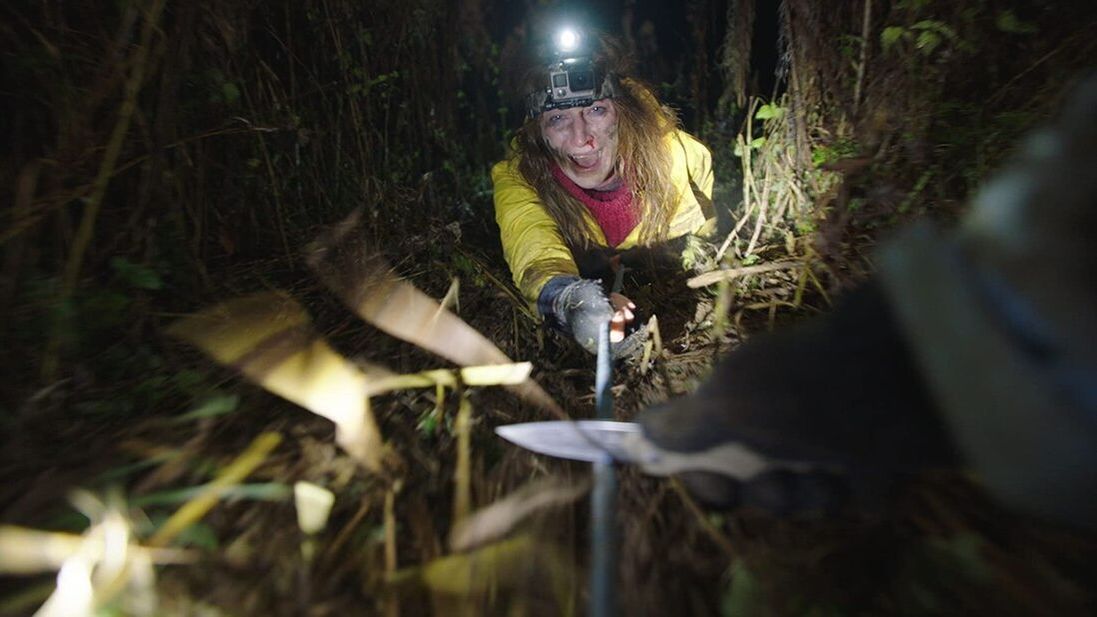 For homebodies like myself, the idea of going into the woods is a solid beginning, middle, and end for a horror film... ...The cold, the darkness, the wild animals… all these elements contribute to a rich sense of dread and uncertainty. Writer-director Ivan Minin’s Russian film The Widow (Vdova in the native tongue), written with Svyatoslav Podgaevsky, Ivan Kapitonov, Nataliya Dubovaya, and Viktoriya Potemina takes these elemental fears, drops them in a pot, and sweetens the sauce with an enjoyable fairytale backstory that results in a moody, atmospheric horror film that is sure to delight. The Widow takes many cues from the horror stories and fairytales many of us were raised on. Much like “Hansel and Gretel” or “Little Red Riding Hood”, the story begins with somebody venturing into a dark and dangerous wood from which few return. In this film, we are following a small team of volunteer rescuers and a documentary filmmaker who is accompanying them on a normal day of training and operations. We are told that this forest is so large and densely wooded that it is actually quite unlikely that the team will find the people they are searching for. While new member Vika (Viktoriya Potemina) is being trained on how to patch a wound, the call comes in that a teenager is missing near the training site. Vika and team mount up and go deep into the forest to search for the missing child. What they find instead is much worse, and soon they realize that there is no escape from the forest. The Widow relies heavily on its locations to present much of the film's fear factor. Filled with foreboding shots of eerie trees amongst inky darkness, the film makes a frightening and isolating setting suitably scary. With every step the characters take deeper into the woods, we find ourselves further immersed in dread. The ever-increasing level of atmospheric terror means there is no release from the fear, making this a riveting film from beginning to end. The film’s lack of jump scares and gore speaks to the influence fairytales and children’s horror has on the movie. It is easy to forget that in those timeless tales, the big scary moment does not occur until the story’s close. “Hansel and Gretel” is mostly just kids walking around until their capture, with the climactic witch-in-the-oven scene at the very end. The oven isn’t what kept me awake at night as a child, though; it was the slow journey into the dark woods, the sense of hunger and fear that overcomes the children when they realize they are horribly lost, and the feeling of being trapped. The Widow perfectly captures and conveys the haunting dread of children’s tales and camping stories. It may follow this guide a little too closely, however. The film sometimes lacks a certain amount of creativity; scenes and interactions are almost too familiar and the few twists and turns of the story feel obvious. One of the strongest aspects of the film is its commitment to giving each character the time they need to fully develop. This small band of rescue workers do not fit into simple archetypes like “the reluctant hero,” “the tough guy, or “the nerd.” Rather, they are sympathetic and believable. This attention to the characters themselves over the scares or the monster draws viewers into the tale and makes scenarios so much more frightening and deaths that much more impactful. The Widow seems to be in conversation with the ways in which modern society and technology are no match for the cruel indifference of nature. Our protagonists are equipped with the latest in GPS and mapping systems and their radio communications are powerful, as is their mobile station. But when they find themselves lost in the forest, all their clever toys simply cannot compete with the trees, the mud, and the evil that refuses to let them leave. This is the heart of good horror. Building a situation where the only way out is death is inherently frightening. The film’s lack of messaging and hope is distinctly Russian and perfect for the genre. The film does make a curious misstep that holds it back from its full potential. In the very beginning, we are told that the story takes place in 2017 and is a true account of events. The film’s inclusion of a documentarian who is filming everything and who has GoPros on most characters’ heads indicates that at some point in the filmmaking process, this movie was intended to be of the “found footage” genre. While we do frequently see footage from GoPros and the documentarian’s camera, we also see plenty of shots that are of a far more conventional nature. I found it rather confusing, and it sometimes kept me from fully connecting with the film. I was constantly wondering when the change occurred and if anybody took the time to realize the documentarian character had become superfluous. It doesn’t completely derail it, however; casual viewers may not even give it a second thought. The Widow is a beautifully shot and nicely constructed horror film about isolation and the dark spaces where evil thrives. What the film lacks in creative flourishes it more than makes up for in three dimensional characters, tonal consistency, and effective use of atmosphere. The Widow comes to VOD, Digital and Blu-ray/DVD from Shout! Studios and Scream Factory March 30th. By Mark Gonzales Celebrate Women in Horror Month with us by donating to Cinefemme at: Donate (cinefemme.net)
0 Comments
Leave a Reply. |
Archives
March 2023
|


 RSS Feed
RSS Feed